3D Electrospun Nanofiber-Based Scaffolds: From Preparations and Properties to Tissue Regeneration Applications
- PMID: 34221024
- PMCID: PMC8225450
- DOI: 10.1155/2021/8790143
3D Electrospun Nanofiber-Based Scaffolds: From Preparations and Properties to Tissue Regeneration Applications
Abstract
Electrospun nanofibers have been frequently used for tissue engineering due to their morphological similarities with the extracellular matrix (ECM) and tunable chemical and physical properties for regulating cell behaviors and functions. However, most of the existing electrospun nanofibers have a closely packed two-dimensional (2D) membrane with the intrinsic shortcomings of limited cellular infiltration, restricted nutrition diffusion, and unsatisfied thickness. Three-dimensional (3D) electrospun nanofiber-based scaffolds can provide stem cells with 3D microenvironments and biomimetic fibrous structures. Thus, they have been demonstrated to be good candidates for in vivo repair of different tissues. This review summarizes the recent developments in 3D electrospun nanofiber-based scaffolds (ENF-S) for tissue engineering. Three types of 3D ENF-S fabricated using different approaches classified into electrospun nanofiber 3D scaffolds, electrospun nanofiber/hydrogel composite 3D scaffolds, and electrospun nanofiber/porous matrix composite 3D scaffolds are discussed. New functions for these 3D ENF-S and properties, such as facilitated cell infiltration, 3D fibrous architecture, enhanced mechanical properties, and tunable degradability, meeting the requirements of tissue engineering scaffolds were discovered. The applications of 3D ENF-S in cartilage, bone, tendon, ligament, skeletal muscle, nerve, and cardiac tissue regeneration are then presented with a discussion of current challenges and future directions. Finally, we give summaries and future perspectives of 3D ENF-S in tissue engineering and clinical transformation.
Copyright © 2021 Shanshan Han et al.
Conflict of interest statement
The authors declare no conflict of interest.
Figures
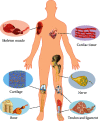
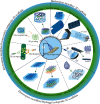
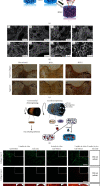


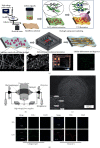
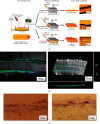
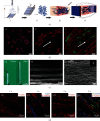
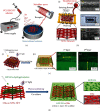
Similar articles
-
CO2-expanded nanofiber scaffolds maintain activity of encapsulated bioactive materials and promote cellular infiltration and positive host response.Acta Biomater. 2018 Mar 1;68:237-248. doi: 10.1016/j.actbio.2017.12.018. Epub 2017 Dec 19. Acta Biomater. 2018. PMID: 29269334 Free PMC article.
-
Electrospun Nanofiber Scaffolds and Their Hydrogel Composites for the Engineering and Regeneration of Soft Tissues.Methods Mol Biol. 2017;1570:261-278. doi: 10.1007/978-1-4939-6840-4_18. Methods Mol Biol. 2017. PMID: 28238143
-
Electrospun Nanofiber Scaffold for Skin Tissue Engineering: A Review.ACS Appl Bio Mater. 2024 Jun 17;7(6):3556-3567. doi: 10.1021/acsabm.4c00318. Epub 2024 May 22. ACS Appl Bio Mater. 2024. PMID: 38777621 Review.
-
Electrospun three-dimensional aligned nanofibrous scaffolds for tissue engineering.Mater Sci Eng C Mater Biol Appl. 2018 Nov 1;92:995-1005. doi: 10.1016/j.msec.2018.06.065. Epub 2018 Jun 30. Mater Sci Eng C Mater Biol Appl. 2018. PMID: 30184829 Review.
-
Aligned conductive core-shell biomimetic scaffolds based on nanofiber yarns/hydrogel for enhanced 3D neurite outgrowth alignment and elongation.Acta Biomater. 2019 Sep 15;96:175-187. doi: 10.1016/j.actbio.2019.06.035. Epub 2019 Jun 29. Acta Biomater. 2019. PMID: 31260823
Cited by
-
3D Cell Culture Systems: Tumor Application, Advantages, and Disadvantages.Int J Mol Sci. 2021 Nov 11;22(22):12200. doi: 10.3390/ijms222212200. Int J Mol Sci. 2021. PMID: 34830082 Free PMC article. Review.
-
Application of gelatin-based composites in bone tissue engineering.Heliyon. 2024 Aug 14;10(16):e36258. doi: 10.1016/j.heliyon.2024.e36258. eCollection 2024 Aug 30. Heliyon. 2024. PMID: 39224337 Free PMC article. Review.
-
Advancements in textile techniques for cardiovascular tissue replacement and repair.APL Bioeng. 2024 Oct 17;8(4):041503. doi: 10.1063/5.0231856. eCollection 2024 Dec. APL Bioeng. 2024. PMID: 39431050 Free PMC article. Review.
-
Fabrication of Aligned Polyhydroxybutyrate Fibrous Scaffolds via a Touchspinning Apparatus.ACS Omega. 2025 May 25;10(22):22735-22746. doi: 10.1021/acsomega.4c11296. eCollection 2025 Jun 10. ACS Omega. 2025. PMID: 40521545 Free PMC article.
-
Nanofiber-based systems intended for diabetes.J Nanobiotechnology. 2021 Oct 12;19(1):317. doi: 10.1186/s12951-021-01065-2. J Nanobiotechnology. 2021. PMID: 34641920 Free PMC article. Review.
References
-
- Guimarães C. F., Gasperini L., Marques A. P., Reis R. L. The stiffness of living tissues and its implications for tissue engineering. Nature Reviews Materials. 2020;5(5):351–370. doi: 10.1038/s41578-019-0169-1. - DOI
Publication types
LinkOut - more resources
Full Text Sources

